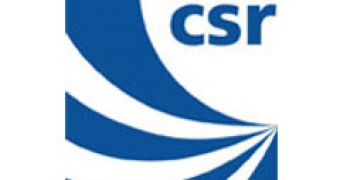CSR announced today the launch of BlueCore BC7830, the smallest device for handsets that include on a single chip GPS, Bluetooth v2.1+EDR, FM transmit and receive technologies, as well as support for Bluetooth low energy. The device measures only 11mm2 in size, supports multiple radio technologies, and can offer manufacturers a way to include GPS functionality in their devices for less than a dollar.
CSR used its ‘Smart Integration’ strategy to be able to achieve this level of integration. Moreover, the company can deliver some of the smallest chip radio designs for any process geometry node. As a result, the devices offer continuous innovation in terms of functionality, size and cost. The company's new device is reportedly 50 percent smaller than the next similar chip that integrates Bluetooth, FM and GPS.
“If we analyse the connectivity growth in handsets, we see the attach rates of Bluetooth, FM and GPS as some of the highest in the mobile handset market. By integrating these three features together in the industry’s smallest device, CSR allows manufacturers to include additional functionality in their devices without sacrificing cost or board space,” said Matthew Phillips, senior vice president of CSR’s Handset Business Unit. He added, “CSR’s Connectivity Centre is continuing to enable designers to drastically increase the features of their devices at impressively lower price points.”
The design of BlueCore BC7830 enables mid-range mobile phones to be added GPS functionality without changes in cost. Location Based Services will also see a boost on the mass market GPS. Not to mention that GPS feature phone applications like geotagging or Google Maps could also become available in a wider range of products. Operators could also see higher revenue streams from LBS, the same as ABI Research has recently forecast.
The upcoming Bluetooth low-energy standard will also find support on BlueCore BC7830. The technology is expected to see a great addition due to its low cost and the small incremental impact in the silicon area. CRS demonstrated Bluetooth low energy in July 2008, and it was predicted to ship in around 428 million devices by 2010.
“Building radio chips on a CMOS process is one of the toughest technical challenges in the semiconductor industry,” said Raj Gawera, vice president of marketing, Handset Business Unit, CSR. “Due to the analogue circuitry, shrinking the size of those chips needs to go beyond the benefits that Moore’s law can provide. The only way to achieve radical size reduction, and therefore cost reduction, is to have deep innovation at an architectural level – this is what we have achieved through our Smart Integration strategy.”
“In contrast, our competitors have followed a dumb integration approach, basically an IP cut and paste methodology with little or no architectural innovation. The result is bloated devices with poor coexistence. Integrating multiple radios is different from regular silicon integration – you can’t just put multiple radios on the same piece of silicon and expect them to work concurrently and without degradation – they need to be architected specifically to work together. That’s where CSR excels because of its heritage of innovation,” he also added.

 14 DAY TRIAL //
14 DAY TRIAL //